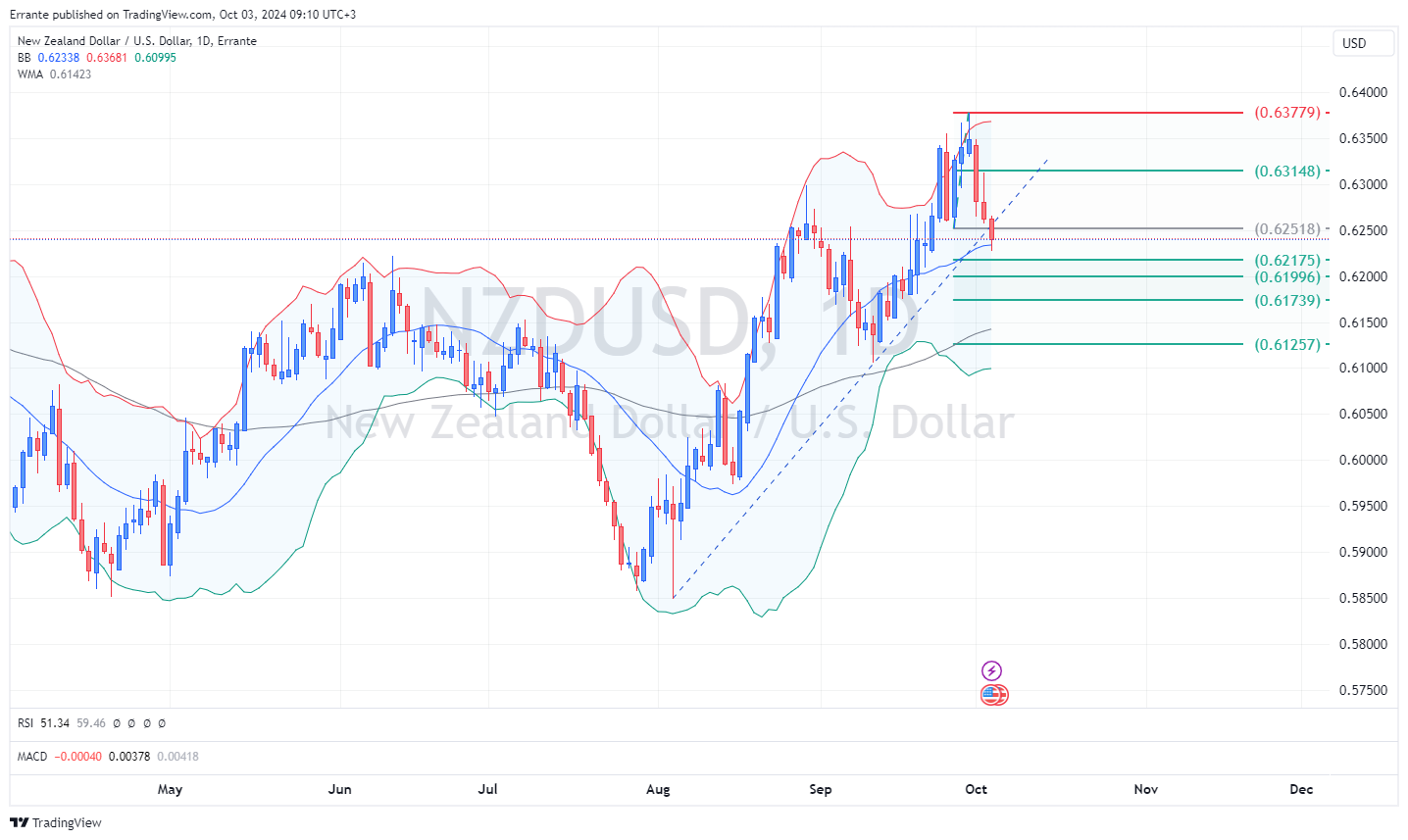In the daily time frame, NZD/USD has entered a corrective phase following a significant uptrend that began in mid-July. After climbing steadily, the pair is now showing signs of weakness, as sellers attempt to capitalize on the recent reversal. The pair remains comfortably above its weighted moving average (WMA), but the emerging downside momentum suggests a potential deeper correction.
The Bollinger Bands are narrowing, indicating reduced volatility, and price action is approaching the middle band, suggesting a temporary loss of bullish momentum. A sustained move below the middle band could signal the beginning of a larger retracement.
Momentum indicators confirm this bearish outlook. The Relative Strength Index (RSI) has dropped to 51.34, highlighting a shift from bullish conditions to more neutral territory. A continued decline in the RSI could indicate growing selling pressure. Furthermore, the MACD has recently turned negative, with its lines converging, signaling the possibility of extended downside in the coming sessions.
Key Fibonacci retracement levels provide insight into potential support areas. The first significant support lies at 0.62175, and a break below this level could accelerate the downside, targeting 0.61996 and 0.61739. These levels represent key areas of interest for sellers and may act as obstacles to any further decline. Should the bearish momentum persist, the pair could eventually test deeper support at 0.61257.
However, a reversal could still be in the cards if buyers manage to defend these support levels and regain control of the market.
Alternative scenario
On the flip side, if NZD/USD buyers regain momentum, the pair could rise toward key resistance at 0.62518. A break above this level could challenge the next upside targets at 0.63148 and 0.63779. A decisive move above 0.63779 would invalidate the current bearish scenario and signal a potential resumption of the broader uptrend.
Technical indicators summary
RSI: Approaching neutral, but leaning bearish as it drops from overbought levels.
MACD: Bearish, with signals of extended downside.
Bollinger Bands: Narrowing, indicating reduced volatility and potential for further correction.
Key levels overview
Resistance levels:
-
Resistance 1: 0.62518.
-
Resistance 2: 0.63148.
-
Resistance 3: 0.63779.
Current price: 0.62400.
Support levels:
-
Support 1: 0.62175.
-
Support 2: 0.61996.
-
Support 3: 0.61739.
-
Support 4: 0.61257.
Key events to watch
Several economic reports are scheduled for Thursday that could influence NZD/USD. In the US, the focus will be on the weekly jobless claims and the ISM non-manufacturing PMI, which are expected to provide further insights into the strength of the US economy. A strong labor market report could solidify the US dollar's position and apply additional pressure on the New Zealand dollar.
Conversely, if market sentiment shifts toward risk-on behavior, the New Zealand dollar could benefit from improved risk appetite, reversing some of the recent losses. However, as long as the US economic data continues to surprise on the upside, NZD/USD may struggle to regain bullish momentum.
The content of this material and/or any information provided should in no way be construed, expressly or by implication, directly or indirectly, as advice, recommendation, or suggestion of an investment strategy in relation to a financial instrument and is not intended to provide a sufficient basis for making investment decisions in any way. Any information, views or opinions presented in this material have been obtained or derived from sources believed to be reliable, but Errante makes no warranty as to their accuracy or completeness. Errante accepts no liability for losses arising from the use of this data and information. The data and information contained herein are for background purposes only and make no claim to be complete or comprehensive.
Recommended Content
Editors’ Picks

Gold hovers around all-time highs near $3,250
Gold is holding steady near the $3,250 mark, fuelled by robust safe-haven demand, trade war concerns, and a softer-than-expected US inflation gauge. The US Dollar keeps trading with heavy losses around three-year lows.

EUR/USD retreats towards 1.1300 as Wall Street shrugs off trade war headlines
The EUR/USD pair retreated further from its recent multi-month peak at 1.1473 and trades around the 1.1300 mark. Wall Street manages to advance ahead of the weekly close, despite escalating tensions between Washington and Beijing and mounting fears of a US recession. Profit-taking ahead of the close also weighs on the pair.

GBP/USD trims gains, recedes to the 1.3050 zone
GBP/USD now gives away part of the earlier advance to fresh highs near 1.3150. Meanwhile, the US Dollar remains offered amid escalating China-US trade tensions, recession fears in the US, and softer-than-expected US Producer Price data.

Bitcoin, Ethereum, Dogecoin and Cardano stabilze – Why crypto is in limbo
Bitcoin, Ethereum, Dogecoin and Cardano stabilize on Friday as crypto market capitalization steadies around $2.69 trillion. Crypto traders are recovering from the swing in token prices and the Monday bloodbath.

Is a recession looming?
Wall Street skyrockets after Trump announces tariff delay. But gains remain limited as Trade War with China continues. Recession odds have eased, but investors remain fearful. The worst may not be over, deeper market wounds still possible.

The Best brokers to trade EUR/USD
SPONSORED Discover the top brokers for trading EUR/USD in 2025. Our list features brokers with competitive spreads, fast execution, and powerful platforms. Whether you're a beginner or an expert, find the right partner to navigate the dynamic Forex market.
